Swansea University: EG-386 Engineering Management Project Checklist
VerifiedAdded on 2022/08/20
|13
|3516
|16
Report
AI Summary
This report presents an engineering management project checklist, focusing on the design of a wastewater pre-treatment screening system. The report, prepared for Swansea University's College of Engineering, meticulously addresses key aspects such as project sponsorship, business benefits, scope definition, and project success criteria. The checklist evaluates the project's alignment with business objectives and benefits, including the efficient removal of grit, solids, oils, and grease from wastewater to serve a population of 200,000 residents. The report emphasizes the importance of a balanced system design, incorporating mass and energy balance principles, and the selection of appropriate technologies, such as catenary bar screens and aerated grit and grease removal tanks. The report also includes a detailed benefits hierarchy and benefits specification table to ensure effective project management and the achievement of desired outcomes, such as reducing maintenance costs and improving water quality. The assignment emphasizes the importance of each stage of project management and the need to analyze and assess the project at each stage to ensure its success.
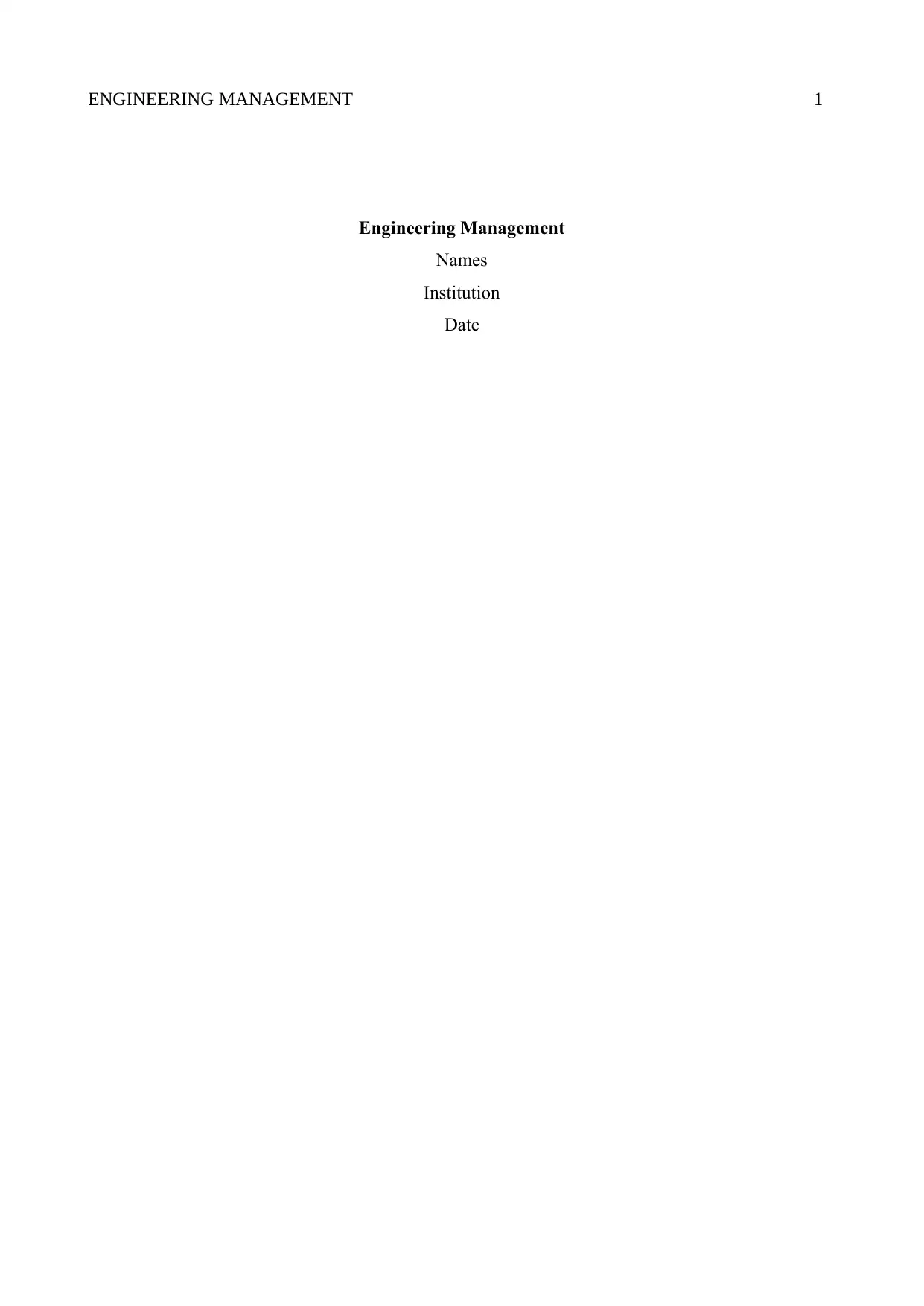
ENGINEERING MANAGEMENT 1
Engineering Management
Names
Institution
Date
Engineering Management
Names
Institution
Date
Paraphrase This Document
Need a fresh take? Get an instant paraphrase of this document with our AI Paraphraser
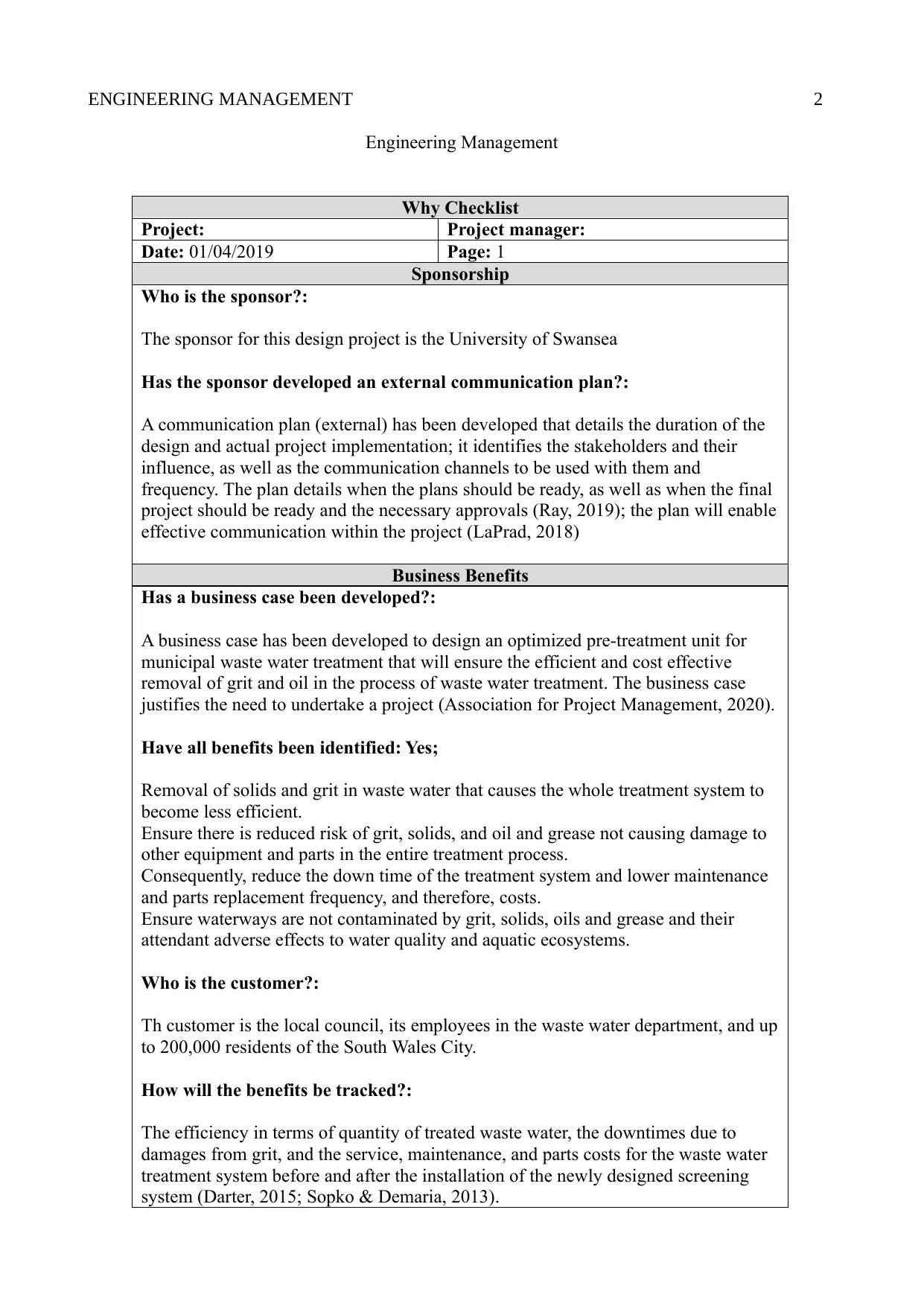
ENGINEERING MANAGEMENT 2
Engineering Management
Why Checklist
Project: Project manager:
Date: 01/04/2019 Page: 1
Sponsorship
Who is the sponsor?:
The sponsor for this design project is the University of Swansea
Has the sponsor developed an external communication plan?:
A communication plan (external) has been developed that details the duration of the
design and actual project implementation; it identifies the stakeholders and their
influence, as well as the communication channels to be used with them and
frequency. The plan details when the plans should be ready, as well as when the final
project should be ready and the necessary approvals (Ray, 2019); the plan will enable
effective communication within the project (LaPrad, 2018)
Business Benefits
Has a business case been developed?:
A business case has been developed to design an optimized pre-treatment unit for
municipal waste water treatment that will ensure the efficient and cost effective
removal of grit and oil in the process of waste water treatment. The business case
justifies the need to undertake a project (Association for Project Management, 2020).
Have all benefits been identified: Yes;
Removal of solids and grit in waste water that causes the whole treatment system to
become less efficient.
Ensure there is reduced risk of grit, solids, and oil and grease not causing damage to
other equipment and parts in the entire treatment process.
Consequently, reduce the down time of the treatment system and lower maintenance
and parts replacement frequency, and therefore, costs.
Ensure waterways are not contaminated by grit, solids, oils and grease and their
attendant adverse effects to water quality and aquatic ecosystems.
Who is the customer?:
Th customer is the local council, its employees in the waste water department, and up
to 200,000 residents of the South Wales City.
How will the benefits be tracked?:
The efficiency in terms of quantity of treated waste water, the downtimes due to
damages from grit, and the service, maintenance, and parts costs for the waste water
treatment system before and after the installation of the newly designed screening
system (Darter, 2015; Sopko & Demaria, 2013).
Engineering Management
Why Checklist
Project: Project manager:
Date: 01/04/2019 Page: 1
Sponsorship
Who is the sponsor?:
The sponsor for this design project is the University of Swansea
Has the sponsor developed an external communication plan?:
A communication plan (external) has been developed that details the duration of the
design and actual project implementation; it identifies the stakeholders and their
influence, as well as the communication channels to be used with them and
frequency. The plan details when the plans should be ready, as well as when the final
project should be ready and the necessary approvals (Ray, 2019); the plan will enable
effective communication within the project (LaPrad, 2018)
Business Benefits
Has a business case been developed?:
A business case has been developed to design an optimized pre-treatment unit for
municipal waste water treatment that will ensure the efficient and cost effective
removal of grit and oil in the process of waste water treatment. The business case
justifies the need to undertake a project (Association for Project Management, 2020).
Have all benefits been identified: Yes;
Removal of solids and grit in waste water that causes the whole treatment system to
become less efficient.
Ensure there is reduced risk of grit, solids, and oil and grease not causing damage to
other equipment and parts in the entire treatment process.
Consequently, reduce the down time of the treatment system and lower maintenance
and parts replacement frequency, and therefore, costs.
Ensure waterways are not contaminated by grit, solids, oils and grease and their
attendant adverse effects to water quality and aquatic ecosystems.
Who is the customer?:
Th customer is the local council, its employees in the waste water department, and up
to 200,000 residents of the South Wales City.
How will the benefits be tracked?:
The efficiency in terms of quantity of treated waste water, the downtimes due to
damages from grit, and the service, maintenance, and parts costs for the waste water
treatment system before and after the installation of the newly designed screening
system (Darter, 2015; Sopko & Demaria, 2013).
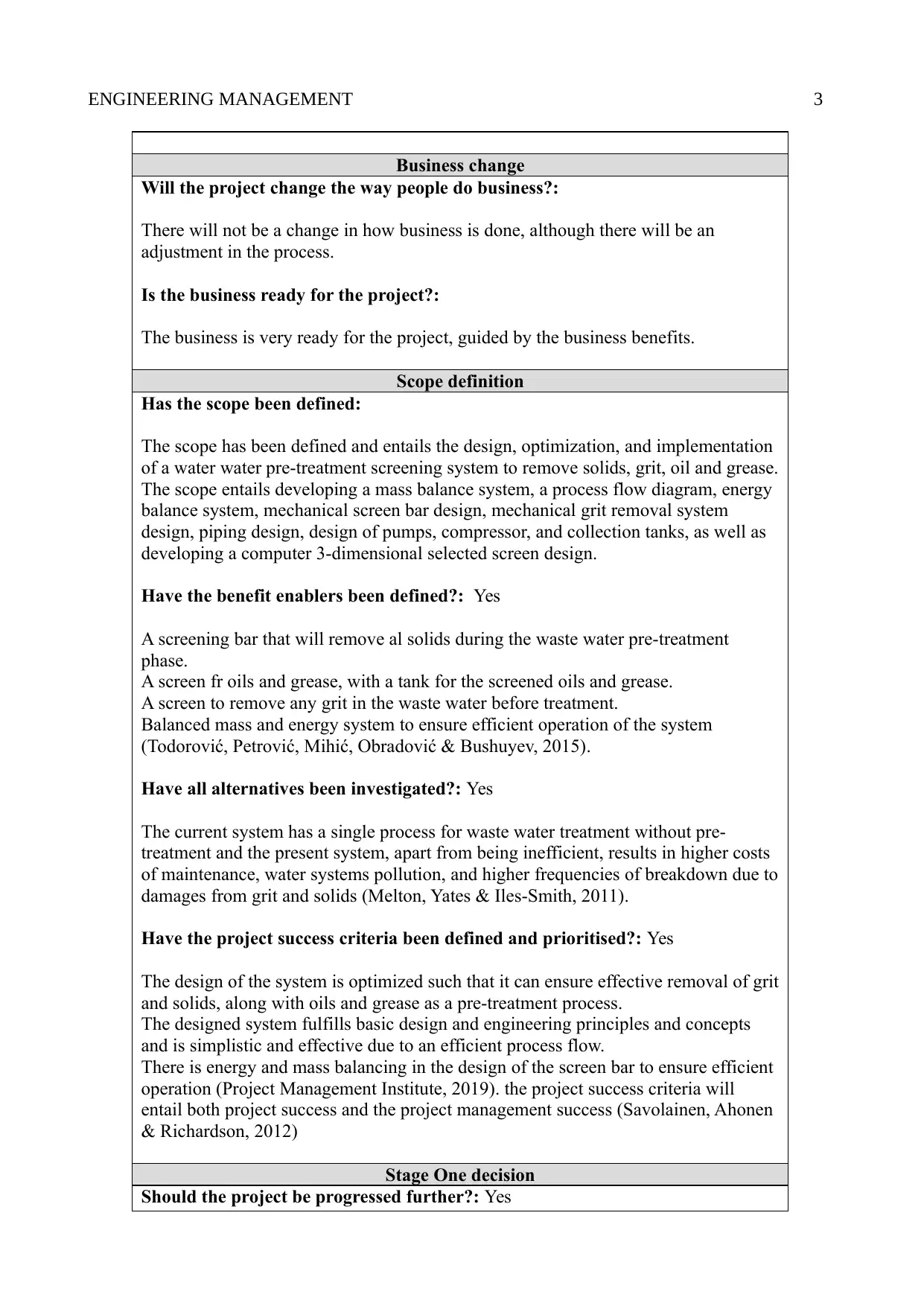
ENGINEERING MANAGEMENT 3
Business change
Will the project change the way people do business?:
There will not be a change in how business is done, although there will be an
adjustment in the process.
Is the business ready for the project?:
The business is very ready for the project, guided by the business benefits.
Scope definition
Has the scope been defined:
The scope has been defined and entails the design, optimization, and implementation
of a water water pre-treatment screening system to remove solids, grit, oil and grease.
The scope entails developing a mass balance system, a process flow diagram, energy
balance system, mechanical screen bar design, mechanical grit removal system
design, piping design, design of pumps, compressor, and collection tanks, as well as
developing a computer 3-dimensional selected screen design.
Have the benefit enablers been defined?: Yes
A screening bar that will remove al solids during the waste water pre-treatment
phase.
A screen fr oils and grease, with a tank for the screened oils and grease.
A screen to remove any grit in the waste water before treatment.
Balanced mass and energy system to ensure efficient operation of the system
(Todorović, Petrović, Mihić, Obradović & Bushuyev, 2015).
Have all alternatives been investigated?: Yes
The current system has a single process for waste water treatment without pre-
treatment and the present system, apart from being inefficient, results in higher costs
of maintenance, water systems pollution, and higher frequencies of breakdown due to
damages from grit and solids (Melton, Yates & Iles-Smith, 2011).
Have the project success criteria been defined and prioritised?: Yes
The design of the system is optimized such that it can ensure effective removal of grit
and solids, along with oils and grease as a pre-treatment process.
The designed system fulfills basic design and engineering principles and concepts
and is simplistic and effective due to an efficient process flow.
There is energy and mass balancing in the design of the screen bar to ensure efficient
operation (Project Management Institute, 2019). the project success criteria will
entail both project success and the project management success (Savolainen, Ahonen
& Richardson, 2012)
Stage One decision
Should the project be progressed further?: Yes
Business change
Will the project change the way people do business?:
There will not be a change in how business is done, although there will be an
adjustment in the process.
Is the business ready for the project?:
The business is very ready for the project, guided by the business benefits.
Scope definition
Has the scope been defined:
The scope has been defined and entails the design, optimization, and implementation
of a water water pre-treatment screening system to remove solids, grit, oil and grease.
The scope entails developing a mass balance system, a process flow diagram, energy
balance system, mechanical screen bar design, mechanical grit removal system
design, piping design, design of pumps, compressor, and collection tanks, as well as
developing a computer 3-dimensional selected screen design.
Have the benefit enablers been defined?: Yes
A screening bar that will remove al solids during the waste water pre-treatment
phase.
A screen fr oils and grease, with a tank for the screened oils and grease.
A screen to remove any grit in the waste water before treatment.
Balanced mass and energy system to ensure efficient operation of the system
(Todorović, Petrović, Mihić, Obradović & Bushuyev, 2015).
Have all alternatives been investigated?: Yes
The current system has a single process for waste water treatment without pre-
treatment and the present system, apart from being inefficient, results in higher costs
of maintenance, water systems pollution, and higher frequencies of breakdown due to
damages from grit and solids (Melton, Yates & Iles-Smith, 2011).
Have the project success criteria been defined and prioritised?: Yes
The design of the system is optimized such that it can ensure effective removal of grit
and solids, along with oils and grease as a pre-treatment process.
The designed system fulfills basic design and engineering principles and concepts
and is simplistic and effective due to an efficient process flow.
There is energy and mass balancing in the design of the screen bar to ensure efficient
operation (Project Management Institute, 2019). the project success criteria will
entail both project success and the project management success (Savolainen, Ahonen
& Richardson, 2012)
Stage One decision
Should the project be progressed further?: Yes
⊘ This is a preview!⊘
Do you want full access?
Subscribe today to unlock all pages.

Trusted by 1+ million students worldwide
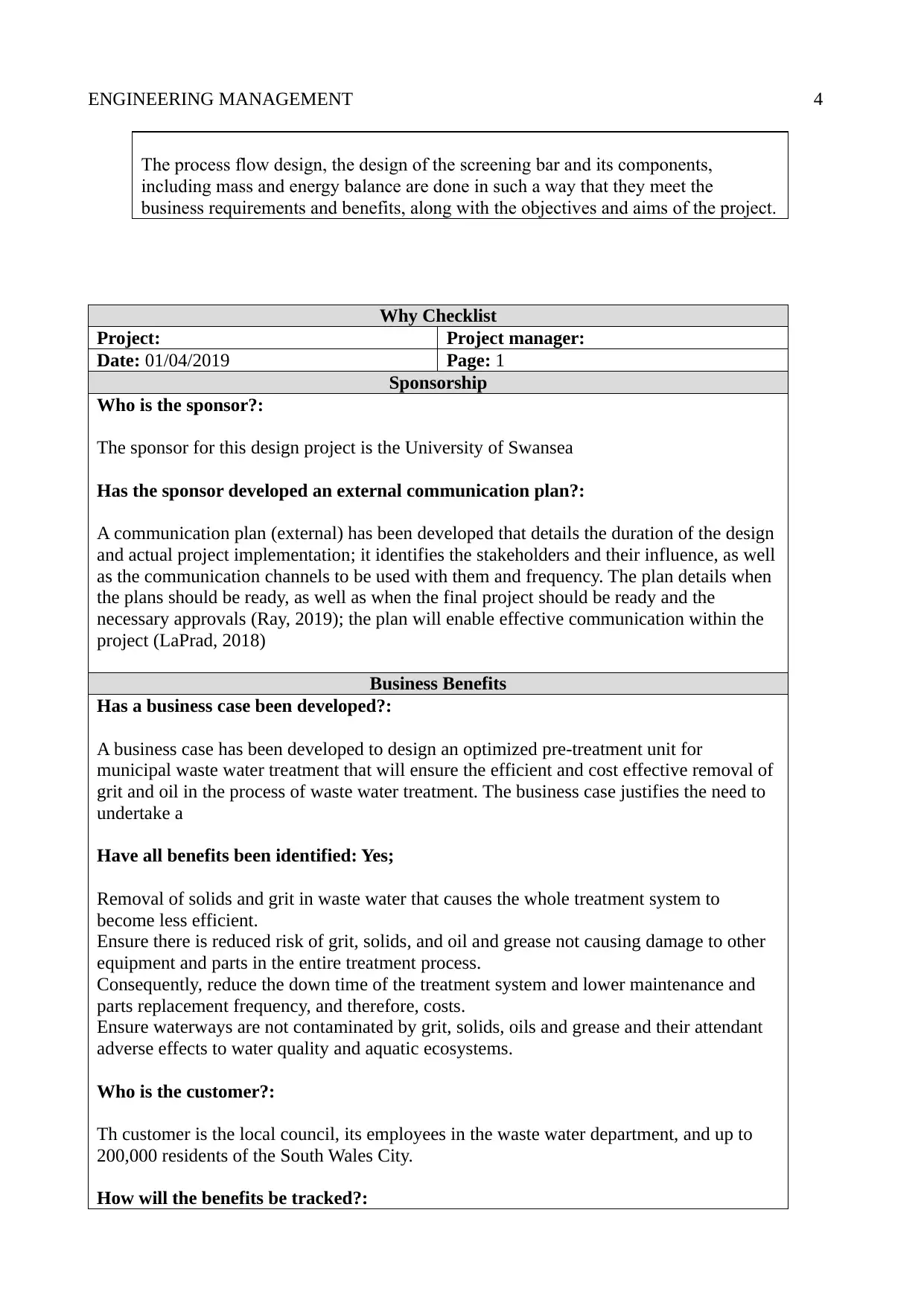
ENGINEERING MANAGEMENT 4
The process flow design, the design of the screening bar and its components,
including mass and energy balance are done in such a way that they meet the
business requirements and benefits, along with the objectives and aims of the project.
Why Checklist
Project: Project manager:
Date: 01/04/2019 Page: 1
Sponsorship
Who is the sponsor?:
The sponsor for this design project is the University of Swansea
Has the sponsor developed an external communication plan?:
A communication plan (external) has been developed that details the duration of the design
and actual project implementation; it identifies the stakeholders and their influence, as well
as the communication channels to be used with them and frequency. The plan details when
the plans should be ready, as well as when the final project should be ready and the
necessary approvals (Ray, 2019); the plan will enable effective communication within the
project (LaPrad, 2018)
Business Benefits
Has a business case been developed?:
A business case has been developed to design an optimized pre-treatment unit for
municipal waste water treatment that will ensure the efficient and cost effective removal of
grit and oil in the process of waste water treatment. The business case justifies the need to
undertake a
Have all benefits been identified: Yes;
Removal of solids and grit in waste water that causes the whole treatment system to
become less efficient.
Ensure there is reduced risk of grit, solids, and oil and grease not causing damage to other
equipment and parts in the entire treatment process.
Consequently, reduce the down time of the treatment system and lower maintenance and
parts replacement frequency, and therefore, costs.
Ensure waterways are not contaminated by grit, solids, oils and grease and their attendant
adverse effects to water quality and aquatic ecosystems.
Who is the customer?:
Th customer is the local council, its employees in the waste water department, and up to
200,000 residents of the South Wales City.
How will the benefits be tracked?:
The process flow design, the design of the screening bar and its components,
including mass and energy balance are done in such a way that they meet the
business requirements and benefits, along with the objectives and aims of the project.
Why Checklist
Project: Project manager:
Date: 01/04/2019 Page: 1
Sponsorship
Who is the sponsor?:
The sponsor for this design project is the University of Swansea
Has the sponsor developed an external communication plan?:
A communication plan (external) has been developed that details the duration of the design
and actual project implementation; it identifies the stakeholders and their influence, as well
as the communication channels to be used with them and frequency. The plan details when
the plans should be ready, as well as when the final project should be ready and the
necessary approvals (Ray, 2019); the plan will enable effective communication within the
project (LaPrad, 2018)
Business Benefits
Has a business case been developed?:
A business case has been developed to design an optimized pre-treatment unit for
municipal waste water treatment that will ensure the efficient and cost effective removal of
grit and oil in the process of waste water treatment. The business case justifies the need to
undertake a
Have all benefits been identified: Yes;
Removal of solids and grit in waste water that causes the whole treatment system to
become less efficient.
Ensure there is reduced risk of grit, solids, and oil and grease not causing damage to other
equipment and parts in the entire treatment process.
Consequently, reduce the down time of the treatment system and lower maintenance and
parts replacement frequency, and therefore, costs.
Ensure waterways are not contaminated by grit, solids, oils and grease and their attendant
adverse effects to water quality and aquatic ecosystems.
Who is the customer?:
Th customer is the local council, its employees in the waste water department, and up to
200,000 residents of the South Wales City.
How will the benefits be tracked?:
Paraphrase This Document
Need a fresh take? Get an instant paraphrase of this document with our AI Paraphraser
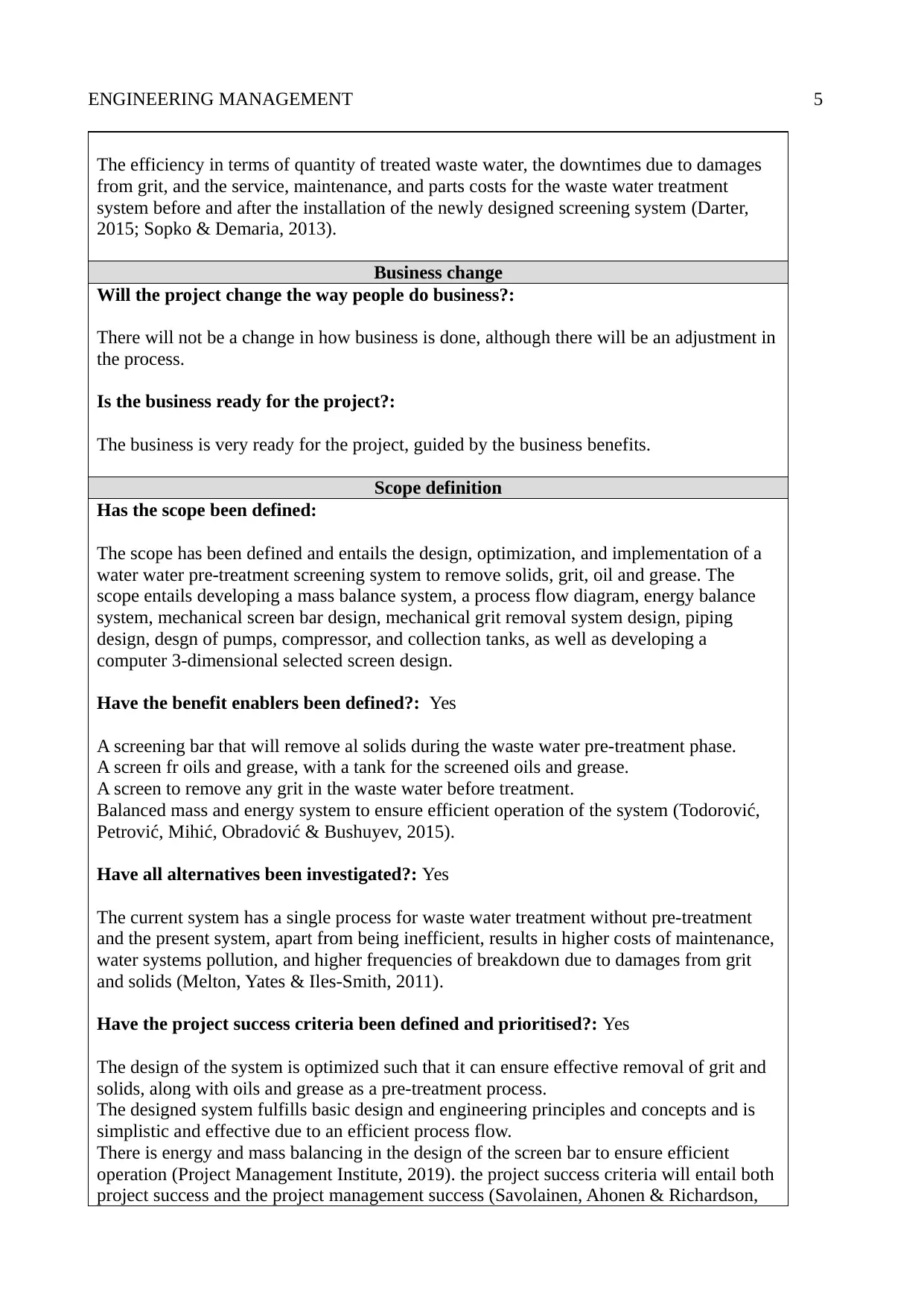
ENGINEERING MANAGEMENT 5
The efficiency in terms of quantity of treated waste water, the downtimes due to damages
from grit, and the service, maintenance, and parts costs for the waste water treatment
system before and after the installation of the newly designed screening system (Darter,
2015; Sopko & Demaria, 2013).
Business change
Will the project change the way people do business?:
There will not be a change in how business is done, although there will be an adjustment in
the process.
Is the business ready for the project?:
The business is very ready for the project, guided by the business benefits.
Scope definition
Has the scope been defined:
The scope has been defined and entails the design, optimization, and implementation of a
water water pre-treatment screening system to remove solids, grit, oil and grease. The
scope entails developing a mass balance system, a process flow diagram, energy balance
system, mechanical screen bar design, mechanical grit removal system design, piping
design, desgn of pumps, compressor, and collection tanks, as well as developing a
computer 3-dimensional selected screen design.
Have the benefit enablers been defined?: Yes
A screening bar that will remove al solids during the waste water pre-treatment phase.
A screen fr oils and grease, with a tank for the screened oils and grease.
A screen to remove any grit in the waste water before treatment.
Balanced mass and energy system to ensure efficient operation of the system (Todorović,
Petrović, Mihić, Obradović & Bushuyev, 2015).
Have all alternatives been investigated?: Yes
The current system has a single process for waste water treatment without pre-treatment
and the present system, apart from being inefficient, results in higher costs of maintenance,
water systems pollution, and higher frequencies of breakdown due to damages from grit
and solids (Melton, Yates & Iles-Smith, 2011).
Have the project success criteria been defined and prioritised?: Yes
The design of the system is optimized such that it can ensure effective removal of grit and
solids, along with oils and grease as a pre-treatment process.
The designed system fulfills basic design and engineering principles and concepts and is
simplistic and effective due to an efficient process flow.
There is energy and mass balancing in the design of the screen bar to ensure efficient
operation (Project Management Institute, 2019). the project success criteria will entail both
project success and the project management success (Savolainen, Ahonen & Richardson,
The efficiency in terms of quantity of treated waste water, the downtimes due to damages
from grit, and the service, maintenance, and parts costs for the waste water treatment
system before and after the installation of the newly designed screening system (Darter,
2015; Sopko & Demaria, 2013).
Business change
Will the project change the way people do business?:
There will not be a change in how business is done, although there will be an adjustment in
the process.
Is the business ready for the project?:
The business is very ready for the project, guided by the business benefits.
Scope definition
Has the scope been defined:
The scope has been defined and entails the design, optimization, and implementation of a
water water pre-treatment screening system to remove solids, grit, oil and grease. The
scope entails developing a mass balance system, a process flow diagram, energy balance
system, mechanical screen bar design, mechanical grit removal system design, piping
design, desgn of pumps, compressor, and collection tanks, as well as developing a
computer 3-dimensional selected screen design.
Have the benefit enablers been defined?: Yes
A screening bar that will remove al solids during the waste water pre-treatment phase.
A screen fr oils and grease, with a tank for the screened oils and grease.
A screen to remove any grit in the waste water before treatment.
Balanced mass and energy system to ensure efficient operation of the system (Todorović,
Petrović, Mihić, Obradović & Bushuyev, 2015).
Have all alternatives been investigated?: Yes
The current system has a single process for waste water treatment without pre-treatment
and the present system, apart from being inefficient, results in higher costs of maintenance,
water systems pollution, and higher frequencies of breakdown due to damages from grit
and solids (Melton, Yates & Iles-Smith, 2011).
Have the project success criteria been defined and prioritised?: Yes
The design of the system is optimized such that it can ensure effective removal of grit and
solids, along with oils and grease as a pre-treatment process.
The designed system fulfills basic design and engineering principles and concepts and is
simplistic and effective due to an efficient process flow.
There is energy and mass balancing in the design of the screen bar to ensure efficient
operation (Project Management Institute, 2019). the project success criteria will entail both
project success and the project management success (Savolainen, Ahonen & Richardson,
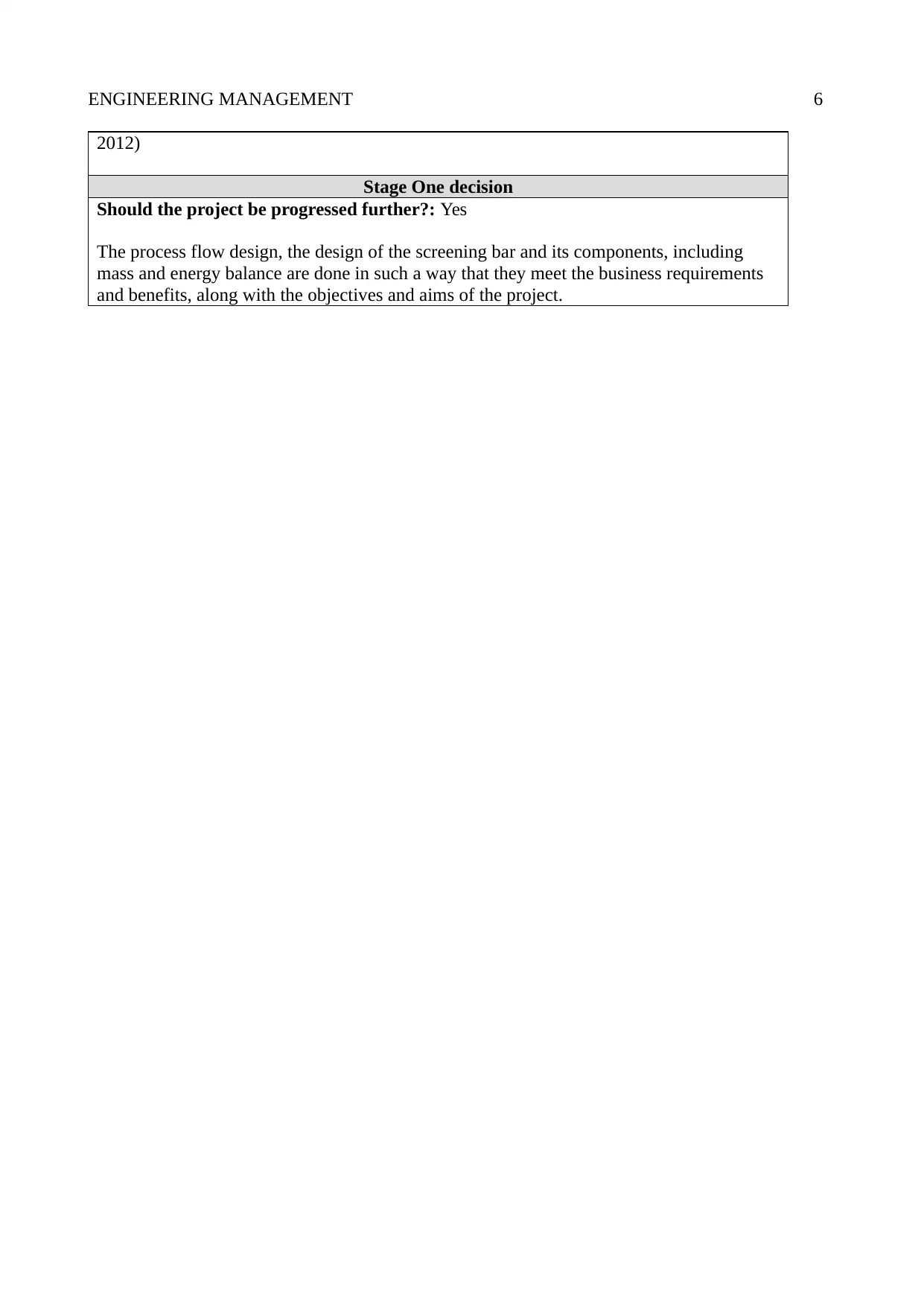
ENGINEERING MANAGEMENT 6
2012)
Stage One decision
Should the project be progressed further?: Yes
The process flow design, the design of the screening bar and its components, including
mass and energy balance are done in such a way that they meet the business requirements
and benefits, along with the objectives and aims of the project.
2012)
Stage One decision
Should the project be progressed further?: Yes
The process flow design, the design of the screening bar and its components, including
mass and energy balance are done in such a way that they meet the business requirements
and benefits, along with the objectives and aims of the project.
⊘ This is a preview!⊘
Do you want full access?
Subscribe today to unlock all pages.

Trusted by 1+ million students worldwide
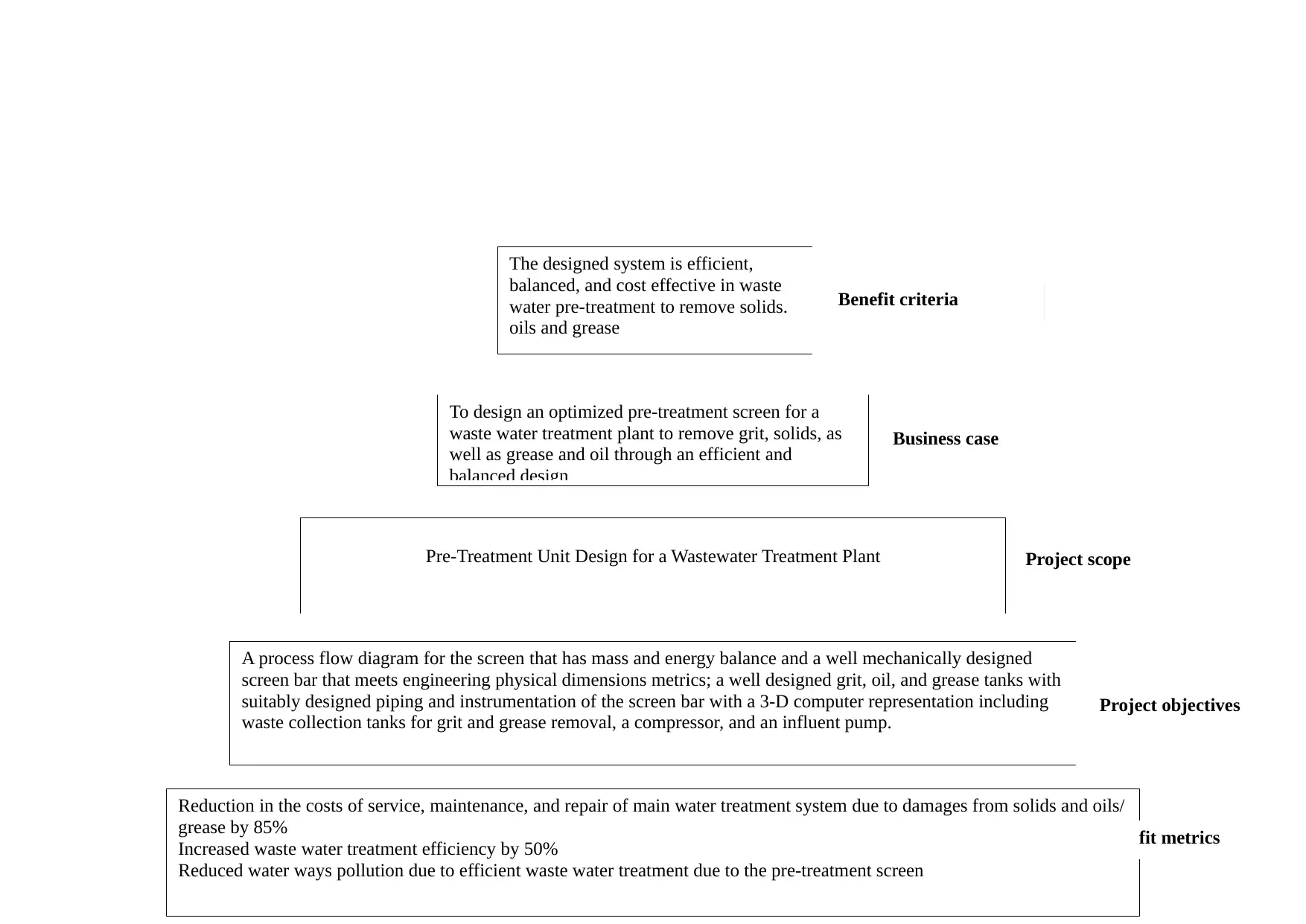
Benefit criteria
Business case
Project scope
Project objectives
Benefit metrics
To design an optimized pre-treatment screen for a
waste water treatment plant to remove grit, solids, as
well as grease and oil through an efficient and
balanced design
Reduction in the costs of service, maintenance, and repair of main water treatment system due to damages from solids and oils/
grease by 85%
Increased waste water treatment efficiency by 50%
Reduced water ways pollution due to efficient waste water treatment due to the pre-treatment screen
A process flow diagram for the screen that has mass and energy balance and a well mechanically designed
screen bar that meets engineering physical dimensions metrics; a well designed grit, oil, and grease tanks with
suitably designed piping and instrumentation of the screen bar with a 3-D computer representation including
waste collection tanks for grit and grease removal, a compressor, and an influent pump.
Pre-Treatment Unit Design for a Wastewater Treatment Plant
The designed system is efficient,
balanced, and cost effective in waste
water pre-treatment to remove solids.
oils and grease
Business case
Project scope
Project objectives
Benefit metrics
To design an optimized pre-treatment screen for a
waste water treatment plant to remove grit, solids, as
well as grease and oil through an efficient and
balanced design
Reduction in the costs of service, maintenance, and repair of main water treatment system due to damages from solids and oils/
grease by 85%
Increased waste water treatment efficiency by 50%
Reduced water ways pollution due to efficient waste water treatment due to the pre-treatment screen
A process flow diagram for the screen that has mass and energy balance and a well mechanically designed
screen bar that meets engineering physical dimensions metrics; a well designed grit, oil, and grease tanks with
suitably designed piping and instrumentation of the screen bar with a 3-D computer representation including
waste collection tanks for grit and grease removal, a compressor, and an influent pump.
Pre-Treatment Unit Design for a Wastewater Treatment Plant
The designed system is efficient,
balanced, and cost effective in waste
water pre-treatment to remove solids.
oils and grease
Paraphrase This Document
Need a fresh take? Get an instant paraphrase of this document with our AI Paraphraser
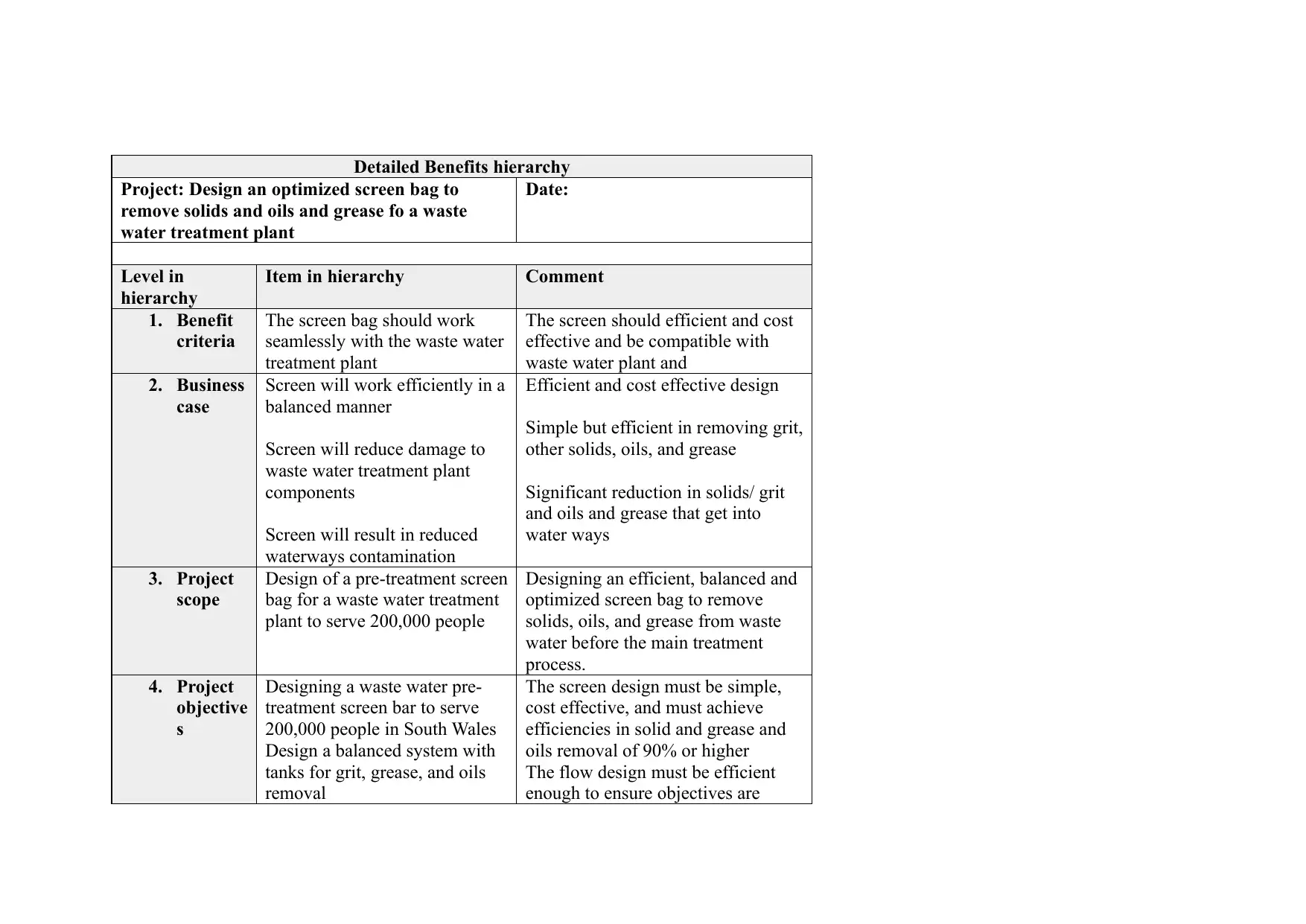
Detailed Benefits hierarchy
Project: Design an optimized screen bag to
remove solids and oils and grease fo a waste
water treatment plant
Date:
Level in
hierarchy
Item in hierarchy Comment
1. Benefit
criteria
The screen bag should work
seamlessly with the waste water
treatment plant
The screen should efficient and cost
effective and be compatible with
waste water plant and
2. Business
case
Screen will work efficiently in a
balanced manner
Screen will reduce damage to
waste water treatment plant
components
Screen will result in reduced
waterways contamination
Efficient and cost effective design
Simple but efficient in removing grit,
other solids, oils, and grease
Significant reduction in solids/ grit
and oils and grease that get into
water ways
3. Project
scope
Design of a pre-treatment screen
bag for a waste water treatment
plant to serve 200,000 people
Designing an efficient, balanced and
optimized screen bag to remove
solids, oils, and grease from waste
water before the main treatment
process.
4. Project
objective
s
Designing a waste water pre-
treatment screen bar to serve
200,000 people in South Wales
Design a balanced system with
tanks for grit, grease, and oils
removal
The screen design must be simple,
cost effective, and must achieve
efficiencies in solid and grease and
oils removal of 90% or higher
The flow design must be efficient
enough to ensure objectives are
Project: Design an optimized screen bag to
remove solids and oils and grease fo a waste
water treatment plant
Date:
Level in
hierarchy
Item in hierarchy Comment
1. Benefit
criteria
The screen bag should work
seamlessly with the waste water
treatment plant
The screen should efficient and cost
effective and be compatible with
waste water plant and
2. Business
case
Screen will work efficiently in a
balanced manner
Screen will reduce damage to
waste water treatment plant
components
Screen will result in reduced
waterways contamination
Efficient and cost effective design
Simple but efficient in removing grit,
other solids, oils, and grease
Significant reduction in solids/ grit
and oils and grease that get into
water ways
3. Project
scope
Design of a pre-treatment screen
bag for a waste water treatment
plant to serve 200,000 people
Designing an efficient, balanced and
optimized screen bag to remove
solids, oils, and grease from waste
water before the main treatment
process.
4. Project
objective
s
Designing a waste water pre-
treatment screen bar to serve
200,000 people in South Wales
Design a balanced system with
tanks for grit, grease, and oils
removal
The screen design must be simple,
cost effective, and must achieve
efficiencies in solid and grease and
oils removal of 90% or higher
The flow design must be efficient
enough to ensure objectives are
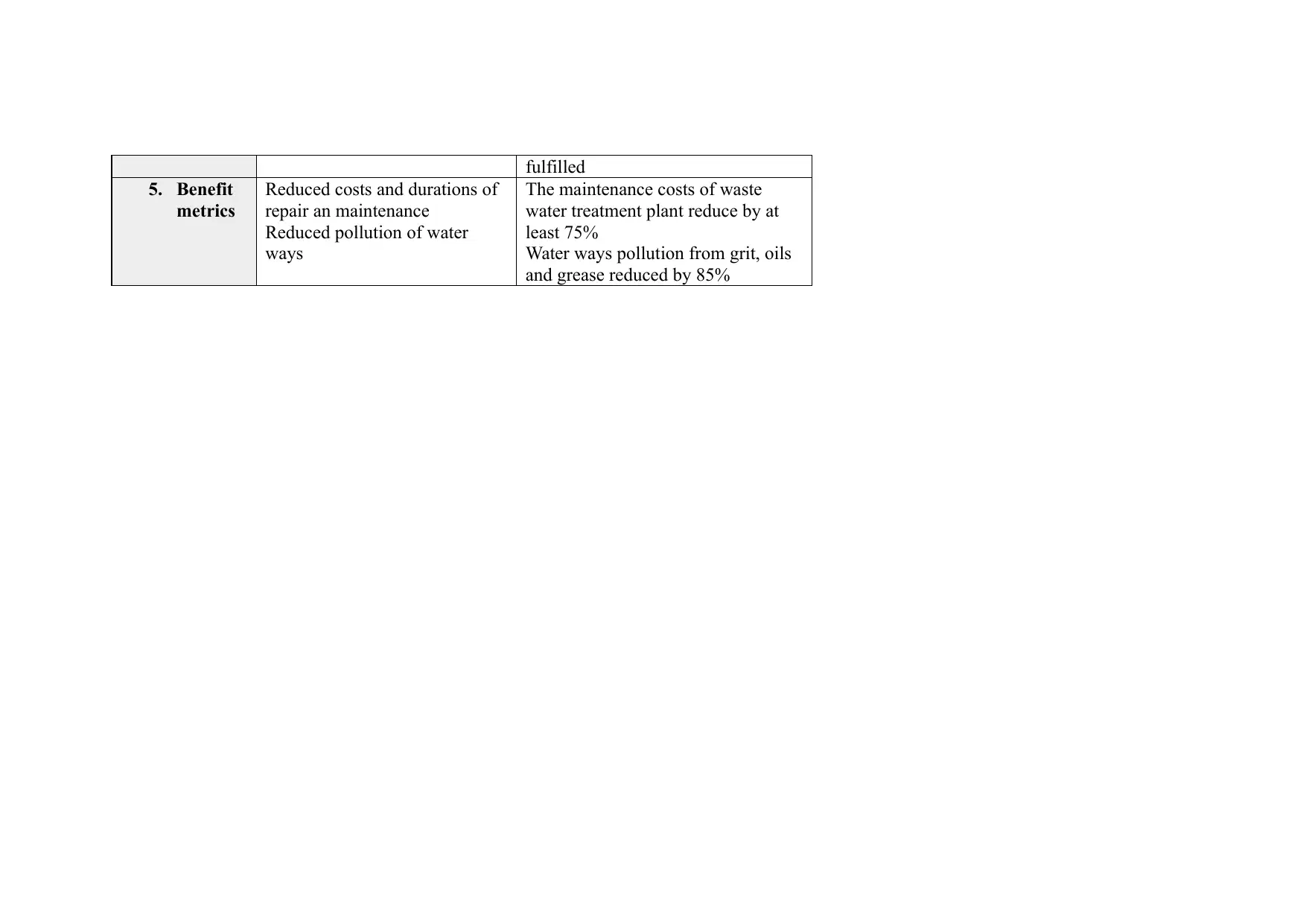
fulfilled
5. Benefit
metrics
Reduced costs and durations of
repair an maintenance
Reduced pollution of water
ways
The maintenance costs of waste
water treatment plant reduce by at
least 75%
Water ways pollution from grit, oils
and grease reduced by 85%
5. Benefit
metrics
Reduced costs and durations of
repair an maintenance
Reduced pollution of water
ways
The maintenance costs of waste
water treatment plant reduce by at
least 75%
Water ways pollution from grit, oils
and grease reduced by 85%
⊘ This is a preview!⊘
Do you want full access?
Subscribe today to unlock all pages.

Trusted by 1+ million students worldwide
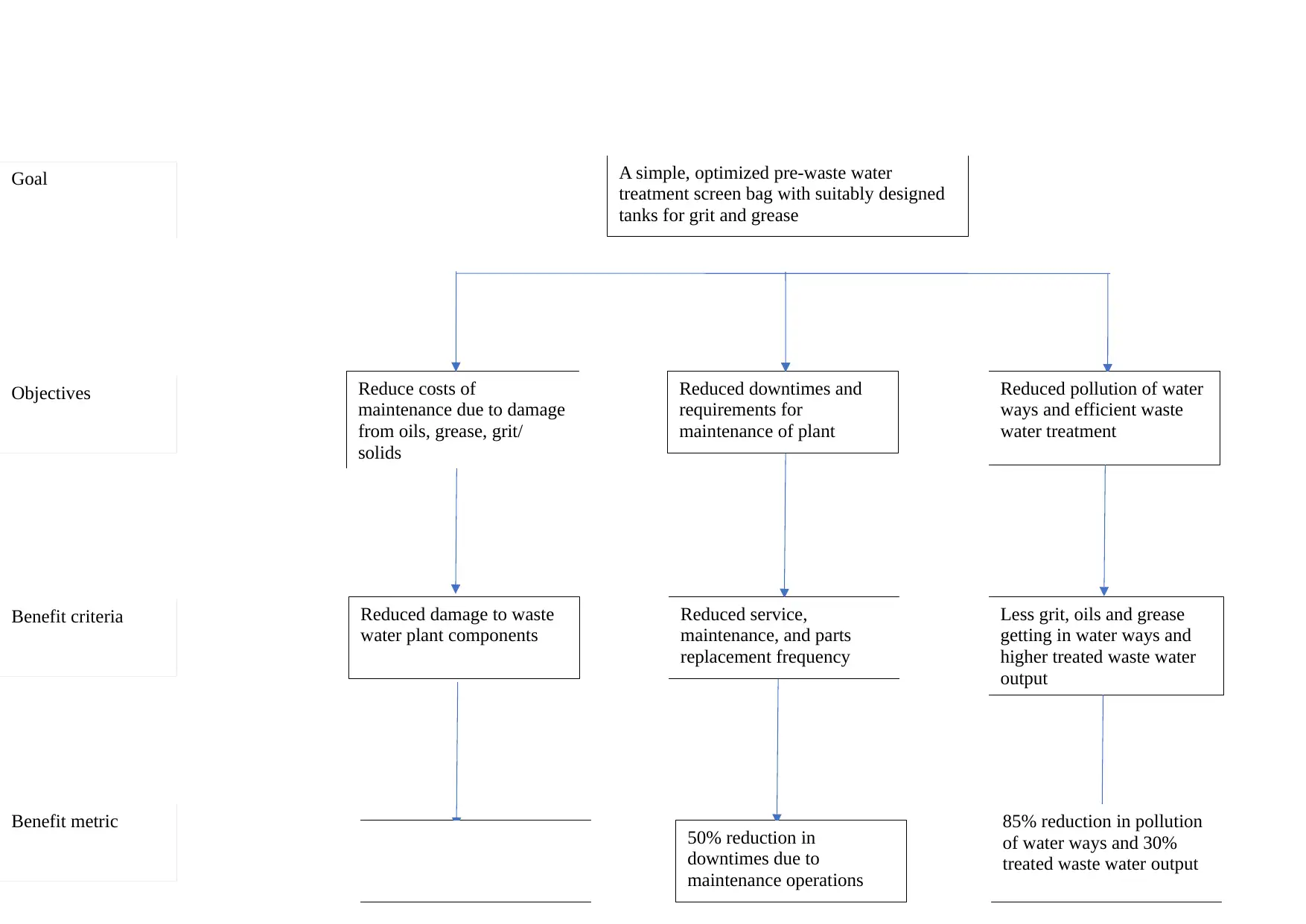
redu tion in aintena e75% c m c
ostsc
A simple, optimized pre-waste water
treatment screen bag with suitably designed
tanks for grit and grease
85% reduction in pollution
of water ways and 30%
treated waste water output
50% reduction in
downtimes due to
maintenance operations
Less grit, oils and grease
getting in water ways and
higher treated waste water
output
Reduced service,
maintenance, and parts
replacement frequency
Reduced damage to waste
water plant components
Reduced pollution of water
ways and efficient waste
water treatment
Reduced downtimes and
requirements for
maintenance of plant
Reduce costs of
maintenance due to damage
from oils, grease, grit/
solids
Goal
Objectives
Benefit criteria
Benefit metric
ostsc
A simple, optimized pre-waste water
treatment screen bag with suitably designed
tanks for grit and grease
85% reduction in pollution
of water ways and 30%
treated waste water output
50% reduction in
downtimes due to
maintenance operations
Less grit, oils and grease
getting in water ways and
higher treated waste water
output
Reduced service,
maintenance, and parts
replacement frequency
Reduced damage to waste
water plant components
Reduced pollution of water
ways and efficient waste
water treatment
Reduced downtimes and
requirements for
maintenance of plant
Reduce costs of
maintenance due to damage
from oils, grease, grit/
solids
Goal
Objectives
Benefit criteria
Benefit metric
Paraphrase This Document
Need a fresh take? Get an instant paraphrase of this document with our AI Paraphraser
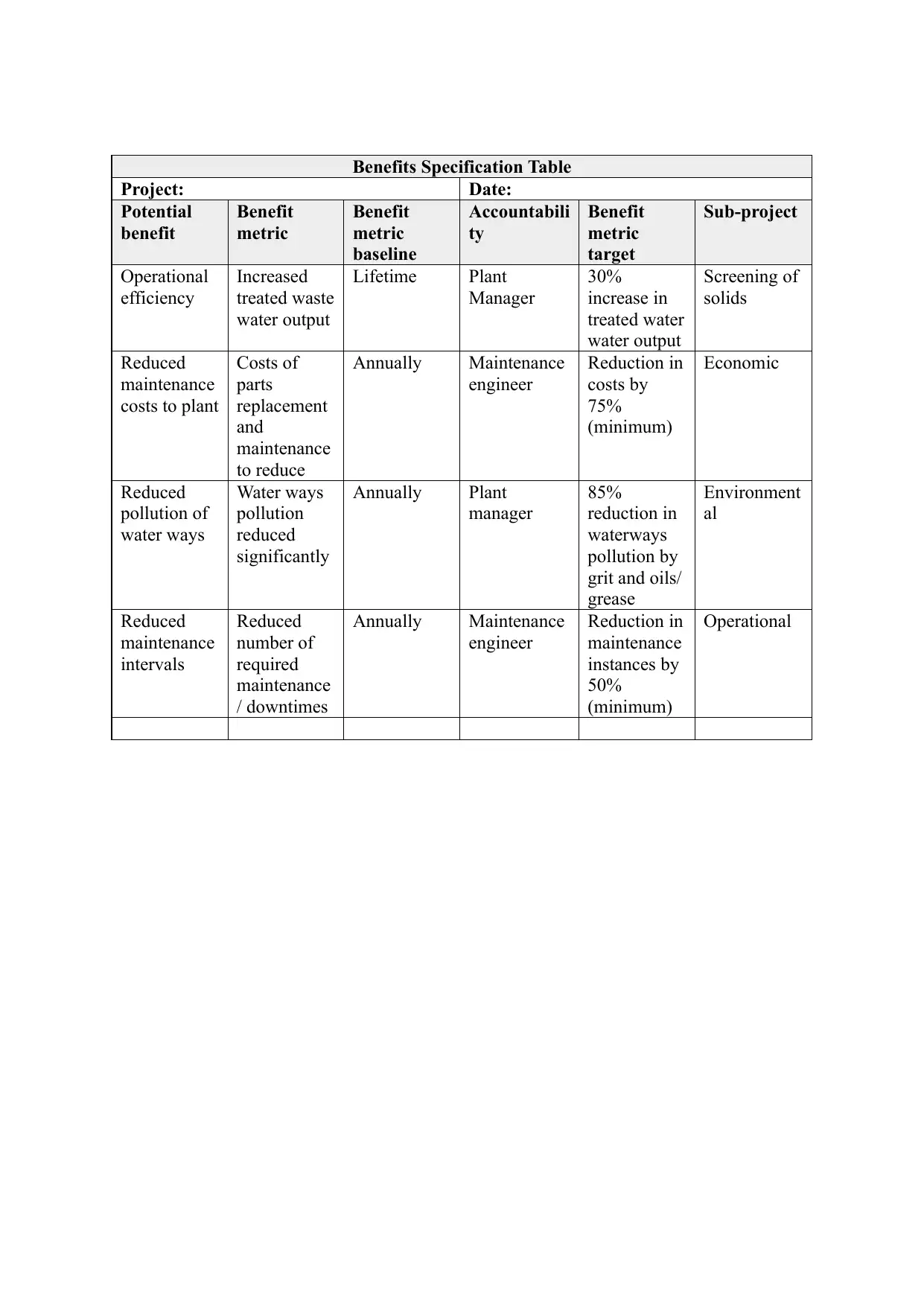
Benefits Specification Table
Project: Date:
Potential
benefit
Benefit
metric
Benefit
metric
baseline
Accountabili
ty
Benefit
metric
target
Sub-project
Operational
efficiency
Increased
treated waste
water output
Lifetime Plant
Manager
30%
increase in
treated water
water output
Screening of
solids
Reduced
maintenance
costs to plant
Costs of
parts
replacement
and
maintenance
to reduce
Annually Maintenance
engineer
Reduction in
costs by
75%
(minimum)
Economic
Reduced
pollution of
water ways
Water ways
pollution
reduced
significantly
Annually Plant
manager
85%
reduction in
waterways
pollution by
grit and oils/
grease
Environment
al
Reduced
maintenance
intervals
Reduced
number of
required
maintenance
/ downtimes
Annually Maintenance
engineer
Reduction in
maintenance
instances by
50%
(minimum)
Operational
Project: Date:
Potential
benefit
Benefit
metric
Benefit
metric
baseline
Accountabili
ty
Benefit
metric
target
Sub-project
Operational
efficiency
Increased
treated waste
water output
Lifetime Plant
Manager
30%
increase in
treated water
water output
Screening of
solids
Reduced
maintenance
costs to plant
Costs of
parts
replacement
and
maintenance
to reduce
Annually Maintenance
engineer
Reduction in
costs by
75%
(minimum)
Economic
Reduced
pollution of
water ways
Water ways
pollution
reduced
significantly
Annually Plant
manager
85%
reduction in
waterways
pollution by
grit and oils/
grease
Environment
al
Reduced
maintenance
intervals
Reduced
number of
required
maintenance
/ downtimes
Annually Maintenance
engineer
Reduction in
maintenance
instances by
50%
(minimum)
Operational
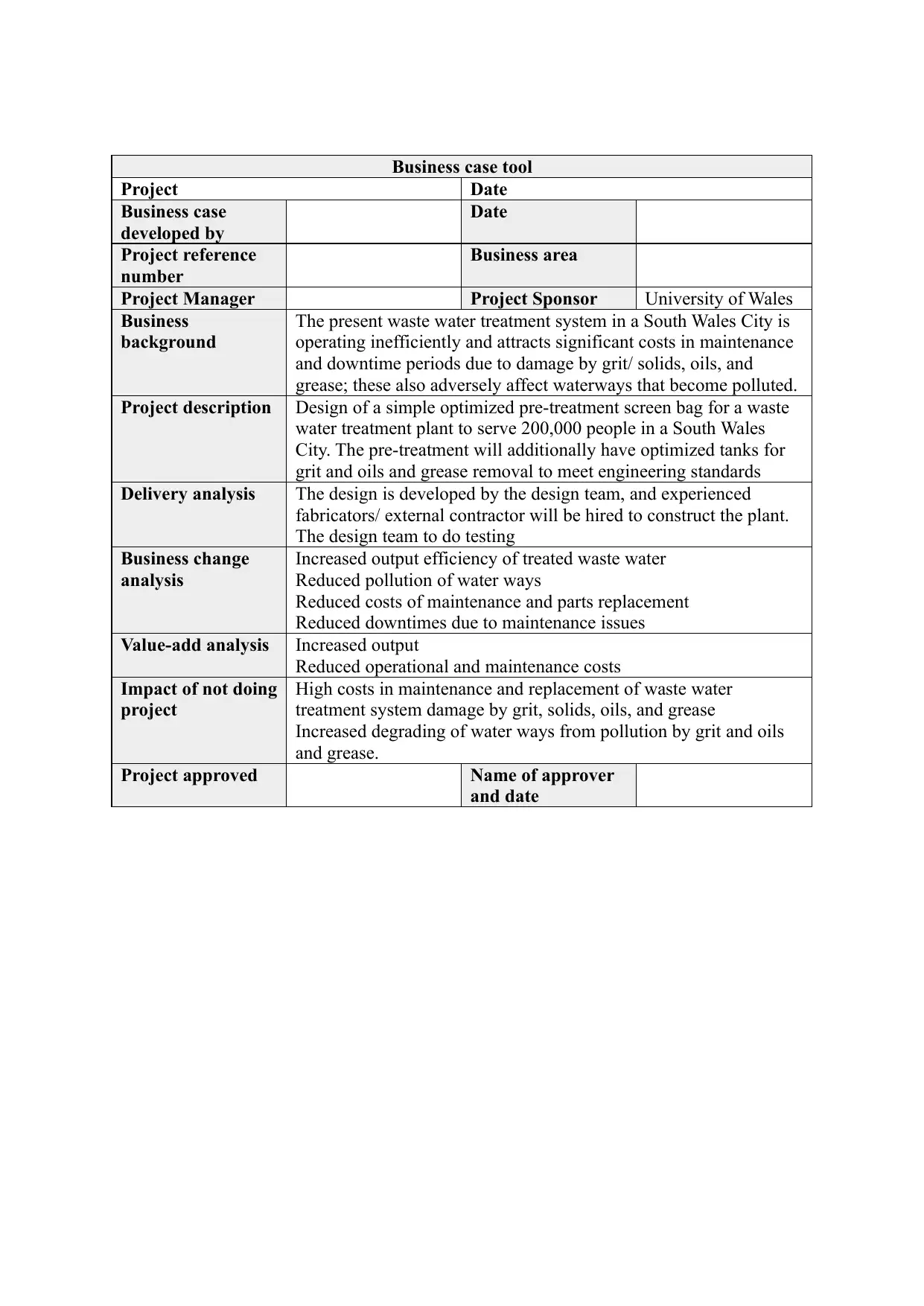
Business case tool
Project Date
Business case
developed by
Date
Project reference
number
Business area
Project Manager Project Sponsor University of Wales
Business
background
The present waste water treatment system in a South Wales City is
operating inefficiently and attracts significant costs in maintenance
and downtime periods due to damage by grit/ solids, oils, and
grease; these also adversely affect waterways that become polluted.
Project description Design of a simple optimized pre-treatment screen bag for a waste
water treatment plant to serve 200,000 people in a South Wales
City. The pre-treatment will additionally have optimized tanks for
grit and oils and grease removal to meet engineering standards
Delivery analysis The design is developed by the design team, and experienced
fabricators/ external contractor will be hired to construct the plant.
The design team to do testing
Business change
analysis
Increased output efficiency of treated waste water
Reduced pollution of water ways
Reduced costs of maintenance and parts replacement
Reduced downtimes due to maintenance issues
Value-add analysis Increased output
Reduced operational and maintenance costs
Impact of not doing
project
High costs in maintenance and replacement of waste water
treatment system damage by grit, solids, oils, and grease
Increased degrading of water ways from pollution by grit and oils
and grease.
Project approved Name of approver
and date
Project Date
Business case
developed by
Date
Project reference
number
Business area
Project Manager Project Sponsor University of Wales
Business
background
The present waste water treatment system in a South Wales City is
operating inefficiently and attracts significant costs in maintenance
and downtime periods due to damage by grit/ solids, oils, and
grease; these also adversely affect waterways that become polluted.
Project description Design of a simple optimized pre-treatment screen bag for a waste
water treatment plant to serve 200,000 people in a South Wales
City. The pre-treatment will additionally have optimized tanks for
grit and oils and grease removal to meet engineering standards
Delivery analysis The design is developed by the design team, and experienced
fabricators/ external contractor will be hired to construct the plant.
The design team to do testing
Business change
analysis
Increased output efficiency of treated waste water
Reduced pollution of water ways
Reduced costs of maintenance and parts replacement
Reduced downtimes due to maintenance issues
Value-add analysis Increased output
Reduced operational and maintenance costs
Impact of not doing
project
High costs in maintenance and replacement of waste water
treatment system damage by grit, solids, oils, and grease
Increased degrading of water ways from pollution by grit and oils
and grease.
Project approved Name of approver
and date
⊘ This is a preview!⊘
Do you want full access?
Subscribe today to unlock all pages.

Trusted by 1+ million students worldwide
1 out of 13
Related Documents
Your All-in-One AI-Powered Toolkit for Academic Success.
+13062052269
info@desklib.com
Available 24*7 on WhatsApp / Email
![[object Object]](/_next/static/media/star-bottom.7253800d.svg)
Unlock your academic potential
Copyright © 2020–2025 A2Z Services. All Rights Reserved. Developed and managed by ZUCOL.





